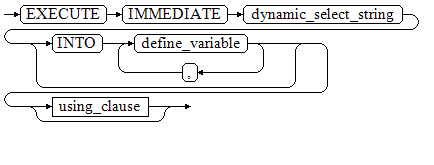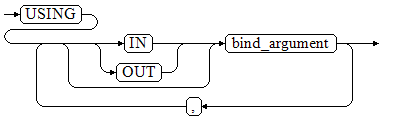Executing Dynamic Query Statements
You can perform dynamic queries using EXECUTE IMMEDIATE or OPEN FOR in DWS. EXECUTE IMMEDIATE dynamically executes SELECT statements and OPEN FOR combines use of cursors. If you need to store query results in a data set, use OPEN FOR.
EXECUTE IMMEDIATE
Figure 1 shows the syntax diagram.
Figure 2 shows the syntax diagram for using_clause.
The above syntax diagram is explained as follows:
- define_variable: specifies variables to store single-line query results.
- USING IN bind_argument: specifies where the variable passed to the dynamic SQL value is stored, that is, in the dynamic placeholder of dynamic_select_string.
- USING OUT bind_argument: specifies where the dynamic SQL returns the value of the variable.

- In query statements, INTO and OUT cannot coexist.
- A placeholder name starts with a colon (:) followed by digits, characters, or strings, corresponding to bind_argument in the USING clause.
- bind_argument can only be a value, variable, or expression. It cannot be a database object such as a table name, column name, and data type. That is, bind_argument cannot be used to transfer schema objects for dynamic SQL statements. If a stored procedure needs to transfer database objects through bind_argument to construct dynamic SQL statements (generally, DDL statements), you are advised to use double vertical bars (||) to concatenate dynamic_select_clause with a database object.
- A dynamic PL/SQL block allows duplicate placeholders. That is, a placeholder can correspond to only one bind_argument in the USING clause.
Example
1 2 3 4 5 6 7 8 9 10 11 12 13 14 15 16 17 18 19 20 21 22 23 24 25 26 27 28 29 |
--Retrieve values from dynamic statements (INTO clause). DECLARE staff_count VARCHAR2(20); BEGIN EXECUTE IMMEDIATE 'select count(*) from staffs' INTO staff_count; dbms_output.put_line(staff_count); END; / --Pass and retrieve values (the INTO clause is used before the USING clause). CREATE OR REPLACE PROCEDURE dynamic_proc AS staff_id NUMBER(6) := 200; first_name VARCHAR2(20); salary NUMBER(8,2); BEGIN EXECUTE IMMEDIATE 'select first_name, salary from staffs where staff_id = :1' INTO first_name, salary USING IN staff_id; dbms_output.put_line(first_name || ' ' || salary); END; / -- Invoke the stored procedure. CALL dynamic_proc(); -- Delete the stored procedure. DROP PROCEDURE dynamic_proc; |
OPEN FOR
Dynamic query statements can be executed by using OPEN FOR to open dynamic cursors.
For details about the syntax, see Figure 3.
Parameter description:
- cursor_name: specifies the name of the cursor to be opened.
- dynamic_string: specifies the dynamic query statement.
- USING value: applies when a placeholder exists in dynamic_string.
For use of cursors, see DWS Stored Procedure Cursors.
Example
1 2 3 4 5 6 7 8 9 10 11 12 13 14 15 16 17 18 19 20 21 |
DECLARE name VARCHAR2(20); phone_number VARCHAR2(20); salary NUMBER(8,2); sqlstr VARCHAR2(1024); TYPE app_ref_cur_type IS REF CURSOR; -- Define the cursor type. my_cur app_ref_cur_type; -- Define the cursor variable. BEGIN sqlstr := 'select first_name,phone_number,salary from staffs where section_id = :1'; OPEN my_cur FOR sqlstr USING '30'; -- Open the cursor. using is optional. FETCH my_cur INTO name, phone_number, salary; -- Retrieve the data. WHILE my_cur%FOUND LOOP dbms_output.put_line(name||'#'||phone_number||'#'||salary); FETCH my_cur INTO name, phone_number, salary; END LOOP; CLOSE my_cur; -- Close the cursor. END; / |
Feedback
Was this page helpful?
Provide feedbackThank you very much for your feedback. We will continue working to improve the documentation.See the reply and handling status in My Cloud VOC.
For any further questions, feel free to contact us through the chatbot.
Chatbot








